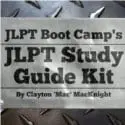
Overview
The N5 is the easiest of all the JLPT levels. A lot of learners overlook this test and move on to higher levels, but it can be a huge help to keep you on track and see where you are with your studies. It is also a good way to check your understanding of hiragana, katakana and around 100 kanji. JLPT, in general, is a little thin on vocabulary and a little heavy on grammar and this level is no exception. You will learn and need to master a lot of grammar points, but only about 1000 vocabulary words. For a more detailed overview of the N5 be sure to check out the full post in English, or give it a try in Japanese.
Practice Tests
There are actually three sets of practice tests available for each level of the JLPT. The first set are called ‘sample questions’. These just have two questions for each section. Basically, it is a good way to get a feel for what the test is like and how difficult it is before taking a full practice test. There are also two full practice tests you can download for free as well. The JLPT website refers to these as ‘workbooks’.
JLPT N5 Sample Questions (Download) or Answer them Online
Grammar
The JLPT is very grammar-heavy. At this level, you will learn most of the grammar that you use on a daily basis. For example, the N5 covers all the basic particles that are used in Japanese like は, が, を, に, へ and even から and まで. You will also need to master using the past, non-past forms and how to make basic clauses.
For grammar, I highly recommend picking up a textbook that will explain each of the grammar points for you. If you are in a hurry and need to master the grammar quickly, you should definitely pick up the N5 JLPT Study Guide. The grammar explanations are short and to the point and there are numerous exercises to help you understand them intuitively.
If you have a little more time, I recommend joining the N5 JLPT Boot Camp. Each grammar point is thoroughly explained and detailed. I’ve also explained all the nuances between easily confused particles like the difference between は and が or に and へ. On top of that, if you have any question about N5 grammar, vocabulary, kanji, reading or listening you can contact me and I will get back to you with an answer. The Boot Camp is constantly being updated with new content to address users questions and concerns. It is the resource for the N5. Check out my video series that goes over each in detail:
Vocabulary
The N5 covers around 1000 of the most common words in Japanese. Most basic Japanese textbooks will cover enough vocabulary for the test. Keep in mind that most lists on the Internet and in most textbooks will cover the core vocabulary used, but you will want to cover your bases by studying as much extra vocabulary as you can. For more details about what kind of vocabulary might come up on the test check out the full blog post on it.
Kanji
There are approximately 103 kanji that you will need to be able to recognize. This includes a whole host of common kanji that you might see in daily life. Keep in mind that some words that are commonly written in kanji will actually be written in hiragana on the test so that you will not need to know how to read the more difficult kanji. This can sometimes actually make it more difficult to recognize words that you have already learned. Don’t let that discourage you from studying words using their native kanji. If you are interested in studying Japanese for the long term it will be much more useful for you. For more details on the kanji for the N5 level, check out the full post on it.
Listening
Listening to N5 material might seem easy enough, but the test will test your ability to understand details from conversations. In addition, you will only be able to hear the conversation once, so you will need to be able to focus well. In real life you are usually able to ask for clarification if you mishear something, but that is not the case for the test. You will have to be on your toes. This is something you will probably need to get used to before the exam, so be sure to check out my post on what each of the N5 questions are and strategies for each.
Reading
The reading section will not only test your comprehension, but your ability to sort out the details of a passage. You will need to know a lot of time vocabulary as well as question words since the questions will be written in Japanese. Be careful to first understand what they are asking and read the answers carefully. Often times the answers will simply be a rewording of something stated in the passage. Be a little weary of answers that contain the same vocabulary words as the passage. Read about the different sections of the N5 Reading Section.
Overview
The N5 is the easiest test, but don’t think it will be walk in the park. You will have to get used to how the questions are asked and the structure of the test before you take it. This is a good warm up test that can help you get over your testing jitters before you move on to the higher levels. Practicing your concentration and listening and reading stamina are excellent reasons to give the N5 level a shot. Good luck on the test!
If you think I missed anything or you have a question about the test, please let me know in the comments below.





Follow Me!